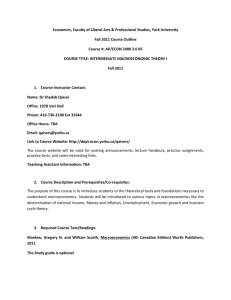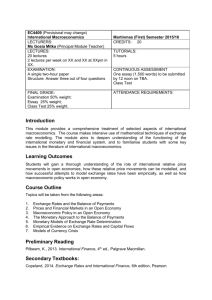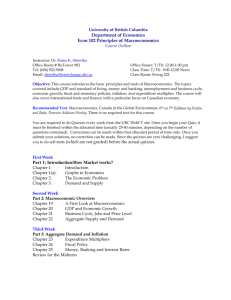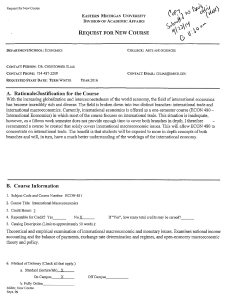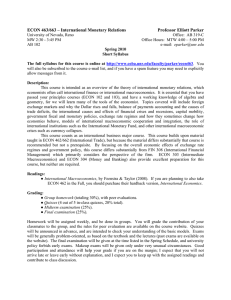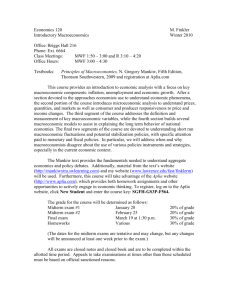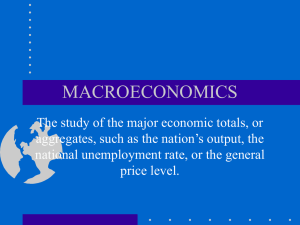Brandeis University Econ 20a - Introduction to Macroeconomics Syllabus
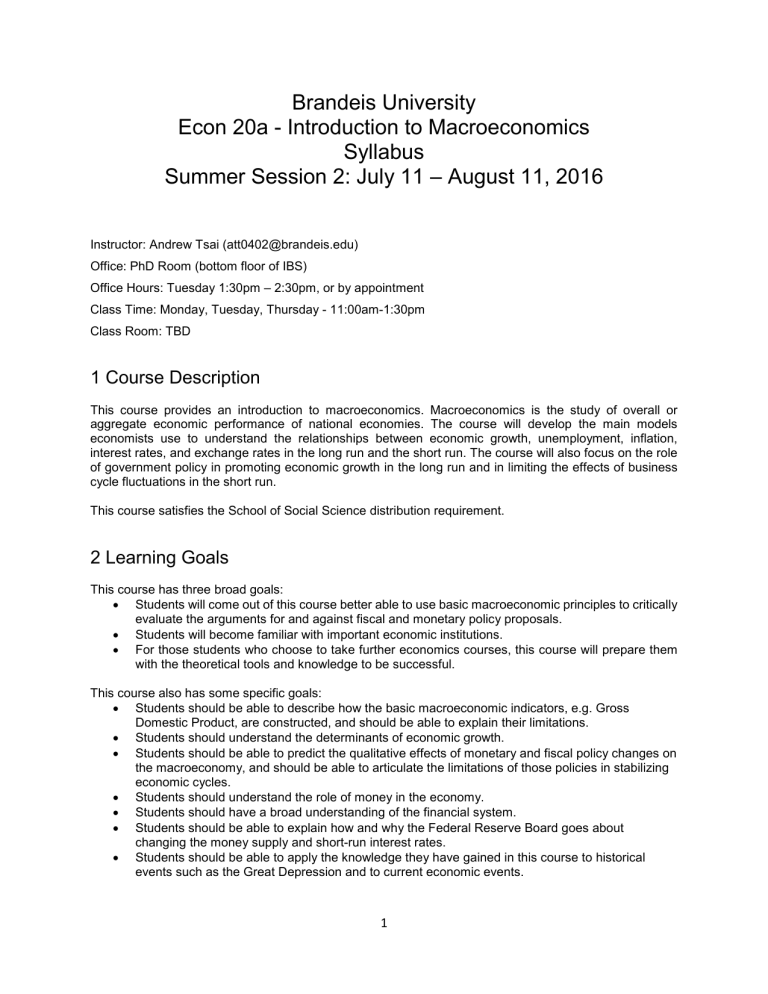
Brandeis University
Econ 20a - Introduction to Macroeconomics
Syllabus
Summer Session 2: July 11 – August 11, 2016
Instructor: Andrew Tsai (att0402@brandeis.edu)
Office: PhD Room (bottom floor of IBS)
Office Hours: Tuesday 1:30pm – 2:30pm, or by appointment
Class Time: Monday, Tuesday, Thursday - 11:00am-1:30pm
Class Room: TBD
1 Course Description
This course provides an introduction to macroeconomics. Macroeconomics is the study of overall or aggregate economic performance of national economies. The course will develop the main models economists use to understand the relationships between economic growth, unemployment, inflation, interest rates, and exchange rates in the long run and the short run. The course will also focus on the role of government policy in promoting economic growth in the long run and in limiting the effects of business cycle fluctuations in the short run.
This course satisfies the School of Social Science distribution requirement.
2 Learning Goals
This course has three broad goals:
•
Students will come out of this course better able to use basic macroeconomic principles to critically evaluate the arguments for and against fiscal and monetary policy proposals.
•
Students will become familiar with important economic institutions.
•
For those students who choose to take further economics courses, this course will prepare them with the theoretical tools and knowledge to be successful.
This course also has some specific goals:
•
Students should be able to describe how the basic macroeconomic indicators, e.g. Gross
Domestic Product, are constructed, and should be able to explain their limitations.
•
Students should understand the determinants of economic growth.
•
Students should be able to predict the qualitative effects of monetary and fiscal policy changes on the macroeconomy, and should be able to articulate the limitations of those policies in stabilizing economic cycles.
•
Students should understand the role of money in the economy.
•
Students should have a broad understanding of the financial system.
•
Students should be able to explain how and why the Federal Reserve Board goes about changing the money supply and short-run interest rates.
•
Students should be able to apply the knowledge they have gained in this course to historical events such as the Great Depression and to current economic events.
1
3 Prerequisites
ECON 10a or Econ 2a
4 Course Materials
The textbook used for this course is Robert E. Hall and Marc Lieberman, Macroeconomics:
Principles and Applications, 6th edition (South-Western Cengage Learning, 2012).
Supplementary materials will be posted in LATTE on a topic-by-topic. You are also encouraged to keep up with current economic events by reading The New York Times, The Economist, and The Financial
Times, or listening to National Public Radio.
5 Course Organization
Assignments and Exams
There will be 2 problem sets, a presentation, a midterm, and a final. For the problem sets you are encouraged to work with other students in the class, but you must write your answers independently. No late problem sets are accepted. The midterm will be based on the first 2 weeks of class, while the final exam will be cumulative with a heavier leaning on the second half of the course.
The presentation will last 5 minutes, will be done individually, and will be based on the Using The
Theory sections at the end of the textbook chapters. More details to follow.
In the event of an excused absence from the scheduled midterm, a make-up exam will be arranged. The grade for an unexcused absence is zero.
University policy does not allow final exams to be given in advance of the published exam time. The makeup for an excused absence from the scheduled final exam will be administered by the Registrar, either on the “conflict resolution” day or after classes resume in the fall.
For a planned absence from the final (one that does not entail an emergency), the student seeking an excused absence must request an “excused absence from a final exam” in advance through the Office of
Undergraduate Academic Affairs.
MIDTERM: In class - Thursday 28 July – 11:00am-1:30pm.
FINAL: Room TBD
Grading
Problem Sets: 20%
Presentation: 5%
Midterm: 25%
Final: 50%
Preparation
Prepare for each lecture by reading the assigned materials in advance. A good strategy would involve reading quickly through the material prior to class and reading more carefully through the same material following the lecture. Lecture notes will be posted on LATTE.
2
6 Academic Integrity
Academic Honesty: You are expected to be honest in all of your academic work.
You are expected to be familiar with and to follow the University’s policies on academic integrity (see http://www.brandeis.edu/studentlife/sdje/ai/).
Instances of alleged dishonesty will be forwarded to the Office of Campus Life for possible referral to the
Student Judicial System. Potential sanctions include failure in the course and suspension from the
University.
Disability Information: If you are a student with a documented disability at Brandeis University and if you wish to request a reasonable accommodation for this class please contact me immediately. Please keep in mind that accommodations cannot be provided retroactively.
Cell phones: No cell phones should be used during class. Please turn off cell phones before class begins and keep them off until class if over.
Laptops: Lecture notes with diagrams are important in this course. If you bring your laptop into the classroom, it should remain closed once class begins. If you have a physical or learning disability that requires use of a laptop, please provide documentation by the second class session.
7 Course Outline (Tentative - Subject to change as the term progresses)
Topic 1: Introduction
•
Week 1: o Intro Econ Review and More: Chapters 1-4 o What is Macroeconomics Tries to Explain : Ch. 5
•
Week 2: o Measuring a Nation’s Income: pg. 134-152 o Measuring Unemployment: pg. 153-169 o The Price Level and Inflation: Ch. 7 & Appendix
Topic 2: The Economy in the Long Run
•
Week 2 (Continued): o The Classical Long-Run Model: Ch. 8
•
Week 3: o Economic Growth and Rising Living Standards: Ch. 9 o Money, Banks, and Central Banks: pg. 356-375 o The Classical Open Economy Model: Ch. 8 Appendix
Topic 3: The Economy in the Short Run
•
Week 4: o Economic Fluctuations: Ch. 10 o The Short-Run Macro Model: Ch. 11 o Fiscal Policy: Ch. 12
•
Week 5: o The Money Market and Monetary Policy: Ch. 14 o Aggregate Demand and Aggregate Supply: Ch. 15 o Conclusion
•
Optional (if time): o Inflation and Monetary Policy: Ch. 16 o Exchange Rates and Macroeconomic Policy: Ch. 17
3
